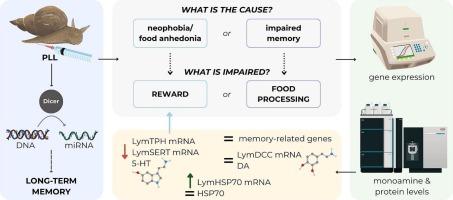Effects of the inhibition of miRNA biogenesis in the central ring ganglia of a widely used invertebrate model species, Lymnaea stagnalis
IF 4.3
3区 环境科学与生态学
Q2 BIOCHEMISTRY & MOLECULAR BIOLOGY
Comparative Biochemistry and Physiology C-toxicology & Pharmacology
Pub Date : 2025-07-15
DOI:10.1016/j.cbpc.2025.110291
引用次数: 0
Abstract
MicroRNAs (miRNAs) are key regulators of gene expression, shaping neuroplasticity, stress responses, and neuromodulation. In the pond snail Lymnaea stagnalis, inhibition of the miRNA-processing enzyme Dicer with Poly-l-Lysine (PLL) has been shown to impair long-term memory (LTM) formation, yet the molecular pathways affected remain unclear. Here, we examined PLL injection's transcriptional and cellular/neurochemical effects in untrained (i.e., non-associatively conditioned) snails. We focused on genes involved in neuroplasticity (LymGRIN1, LymCREB1), stress response (LymHSP70), and serotonergic/dopaminergic signaling (LymTPH, LymSERT, LymDDC), along with measurements of the levels of serotonin, dopamine, and HSP70 protein. We found that PLL did not alter the expression of memory-related genes in the non-associatively conditioned snails. However, we observed a marked downregulation of LymTPH and LymSERT, which was accompanied by a significant reduction in the level of serotonin. In contrast, the expression of LymDDC and the level of dopamine remained unchanged. Although we detected a significant upregulation in the expression of LymHSP70, indicating a strong stress response, the level of HSP70 protein did not change significantly. These findings suggest that PLL-induced Dicer inhibition primarily disrupts serotonin homeostasis, potentially altering motivation and feeding behaviour rather than directly impairing memory processes. This study highlights the broader role of miRNA pathways in regulating stress resilience and neuromodulation. By linking miRNA activity to serotonergic signaling, our findings suggest that miRNAs influence behavioural states beyond synaptic plasticity, with potential implications for understanding how miRNA dysregulation affects mood, motivation, and cognitive function across species.

一种广泛使用的无脊椎动物模式物种——海扁豆中央环神经节中miRNA生物发生的抑制作用
MicroRNAs (miRNAs)是基因表达、形成神经可塑性、应激反应和神经调节的关键调节因子。在塘螺中,聚l-赖氨酸(PLL)抑制mirna加工酶Dicer已被证明会损害长期记忆(LTM)的形成,但受影响的分子途径尚不清楚。在这里,我们检查了PLL注射对未训练(即非联想条件)蜗牛的转录和细胞/神经化学效应。我们重点研究了与神经可塑性(LymGRIN1, LymCREB1),应激反应(LymHSP70),血清素/多巴胺能信号传导(LymTPH, LymSERT, LymDDC)相关的基因,以及血清素,多巴胺和HSP70蛋白水平的测量。我们发现,PLL并没有改变非联想条件蜗牛记忆相关基因的表达。然而,我们观察到LymTPH和lysert的显著下调,这伴随着血清素水平的显著降低。相比之下,LymDDC的表达和多巴胺水平保持不变。虽然我们检测到淋巴sp70的表达明显上调,表明强烈的应激反应,但HSP70蛋白水平没有明显变化。这些发现表明,pll诱导的Dicer抑制主要破坏血清素稳态,可能改变动机和摄食行为,而不是直接损害记忆过程。这项研究强调了miRNA通路在调节应激恢复和神经调节中的广泛作用。通过将miRNA活性与血清素能信号联系起来,我们的研究结果表明,miRNA影响突触可塑性之外的行为状态,这对理解miRNA失调如何影响跨物种的情绪、动机和认知功能具有潜在的意义。
本文章由计算机程序翻译,如有差异,请以英文原文为准。
求助全文
约1分钟内获得全文
求助全文
来源期刊
CiteScore
7.50
自引率
5.10%
发文量
206
审稿时长
30 days
期刊介绍:
Part C: Toxicology and Pharmacology. This journal is concerned with chemical and drug action at different levels of organization, biotransformation of xenobiotics, mechanisms of toxicity, including reactive oxygen species and carcinogenesis, endocrine disruptors, natural products chemistry, and signal transduction with a molecular approach to these fields.

 求助内容:
求助内容: 应助结果提醒方式:
应助结果提醒方式:


